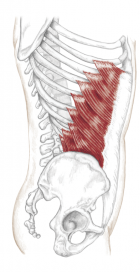One of the most common bracing issues I see with lifters who are still learning to develop proper Intra-Abdominal Pressure (IAP) is a lack of bracing and inflation in the obliques. Very often lifters can fill up their belly with air, even their lower backs with air, but I find the obliques to be the stragglers. Today’s article will go over some concepts and techniques that you can apply to your bracing strategy and training program to help build a more complete brace by learning about skeletal position, training thresholds, and how to build your brace up.
Without getting totally off in the weeds here, the obliques attach the ribcage to the hips. If the ribcage or pelvis is in a position that overly lengthens the obliques (rib flare, anterior pelvic tilt, excess curve in the thoracic and lumbar spine), they will be put in a weakened position. As such, through the rest of this article, we will assume we are discussing the bracing drills in a relatively “neutral” position.
The first step to an effective brace is being able to create outward force with the diaphragm. This creates an eccentric (braking) load on the external core musculature. If you can’t brace your obliques well, our course of action should involve creating that eccentric load through the obliques in order to fast track the bracing technique. In the video above, we discuss how a low oblique sit position can help you to create a proper brace by way of gravity pulling the diaphragm downwards which creates that expansion on the sides. Coupled with load, this is a pretty good basic brace.
From there, we build the athlete up from the ground, eventually ending up in the squat or deadlift pattern that the athlete is working on improving. All these steps are outlined in the video.

One key point to note is that there will be a point where you are unable to maintain your proper IAP brace. This is referred to as a threshold. For some, it’s right as they lift their hand off the floor from an oblique sit, for others, it’s at a certain weight at the bottom of a squat. Regardless, with the goal of building a proper 360 brace, you want to aim to increase your technical threshold with this pattern. The best way to do so is to stay slightly under threshold and “master” the technique in whatever you are working on, along with a slight nudge for progress over time – Just like your regular training where you would do a lot of training around 60-85% of your 1RM in order to improve your max strength.
One common limiting factor with this style of bracing in powerlifters is simply a lack of strength and muscle mass in the obliques. If you aren’t strong enough in a particular position, your body will find a way to make the weight go up even if it’s not your “ideal” technique. In situations like this, some supplemental oblique training can be warranted by way of exercises that challenge the obliques in a more specific way as opposed to the general nature of “bracing during a deadlift”.
Starting out by training frontal plane (side-to-side control) exercises such as side planks, 1 arm split squats, and suitcase carries with a bracing focus is an excellent addition to your powerlifting training program, but as you progress, adding in some transverse plane (rotational work) will further challenge the obliques. The latter category of exercises can consist of movements like Pallof Presses, 1-Arm DB Romanian Deadlifts, and Rhythmic Med Ball Throws.
It certainly takes some time to apply these techniques and get them consistent in your own training but in my powerlifting coaching experience, the result is well worth the extra effort you put in now. Worst case scenario, your obliques start to pop and you can show off a bit with some shirtless pulling at your next deadlift session ;).
PS – Here’s 3 ways I can help you get stronger:
3. Apply to join my “Momentum Program” and become a case study. We’ll work with you 1-on-1 (in-person or online, depending on location) to consistently increase your PRs.
It takes less than 60 seconds to apply HERE in order to find out more information and see if you’d be a good fit.